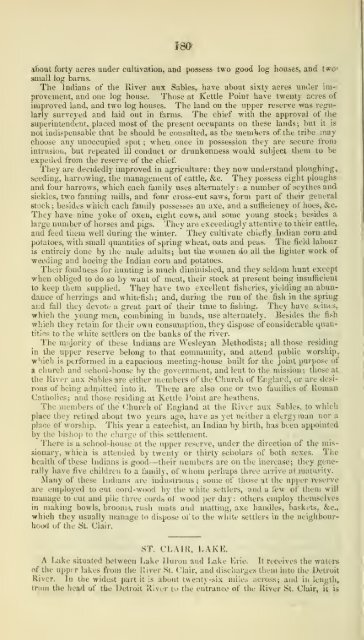Smith's Canadian gazetteer - ElectricCanadian.com
Smith's Canadian gazetteer - ElectricCanadian.com
Smith's Canadian gazetteer - ElectricCanadian.com
Create successful ePaper yourself
Turn your PDF publications into a flip-book with our unique Google optimized e-Paper software.
iboat forty acres under caltivatlon, and possess two good log houses, and twO"<br />
small log barus.<br />
The Indians of the River aux Sables, have about sixty acres under improvement,<br />
and one log house. Those at Kettle Point have twenty acres of<br />
improved land, and two log houses. The land on the upper reserve was regularly<br />
surveyed and laid out in farms. The chief with the approval of the<br />
superintendent, placed most of the present occupants on these lands; but it is<br />
not indispensable that he should be consulted, as the memWrs of the tribe may<br />
choose any unoccupied spot ; when once in possession they are secure from<br />
intrusion, but repeated ill conduct or drunkenness would subject them to be<br />
expelled from the reserve of the chief.<br />
They are decidedlj' improved in agriculture: they now understand ploughing,<br />
seeding, harrowing, the management of cattle, &c. They possess eight ploughs<br />
-.<br />
and four harrows, which each family uses alternately a number of scythes and<br />
sickles, two fanning mills, and four cross-cut saws, form part of their general<br />
stock ; besides which each family possesses an axe, and a sufficiency of hoes, &c.<br />
They have nine yoke of oxen, eight cows, and some young stock; besides a<br />
large number of horses and pigs. They are exceedingly attentive to their cattle,,<br />
and feed tuem well during the winter. They cultivate chiefly Indian corn and<br />
potatoes, with small quantities of spring wheat, oats and peas. The field labour<br />
is entirely done by ihe male adults; but the women do all the lighter work of<br />
weeding and hoeing the Indian corn and potatoes.<br />
Their fondness for hunting is much diminished, and they seldom hunt except<br />
when obliged to do so by want of meat, their stock at present being insufficient<br />
to keep them supplied. They have two excellent fisheries, yielding an abundance<br />
of herrings and whitefish; and, during the run of the fish in the sprhig<br />
and fall thej' devote a great part of their time to fishing. They have seines,<br />
which the young men, <strong>com</strong>bining in bunds, use alternately. Besides the fish<br />
which they retain for their own consumption, they dispose of considerable quantities<br />
to the white settlers on the banks of the river.<br />
The majority of these Indians are Wesleyan Methodists; all those residing<br />
in the upper reserve belong to that <strong>com</strong>munity, and attend public worship,,<br />
which is performed in a capacious meeting-house built for the joint purpose of<br />
a church and school-house by the government, and lent to the mission;<br />
those at<br />
the River aux Sables are either members of the Church of England, or are desirous<br />
of being admitted into it. There are also one or two families of Roman<br />
Catholics; and those residing at Kettle Point are heathens.<br />
The members of the < Ihurch of England at the River aux Sables, to which<br />
place they retired about two years ago, have as yet neither a clergyman nor a<br />
place of worship. This year a catechist, an Indian by birth, has been appointed<br />
by the hishoj) to the charge of this settlement.<br />
There is a school-house at the upper reserve, under the direction of the missionary,<br />
wtiicn i.s attended by twenty or thirty scholars of both sexes. The<br />
health of these Lidians is good—their numbers are cm the increase; they generally<br />
have five chiidron to a family, of whom perhaps three arrive at matuiity.<br />
iVIany of these Indians are industrious ; some of those at the upjier resei've<br />
are employed to cut cord-wood by the white settlers, and a few of them will<br />
manage to cut and pile three cords of wood per day: others employ themselves<br />
in making bowls, brooms, rush mats and matting, axe handles, baskets, &c.,<br />
which they usually manage to dispose of to the wliite settlers in the neighbourhood<br />
of the St. Clair.<br />
ST.<br />
CLAIR, LAKE.<br />
A Lake situated between Lake Huron and Lake Eric. It receives the wattre<br />
of the upper lakes from the lliver St. (^lair, and di.seluirges them into the Detroit<br />
River. In the widest part it Is about t^^e;ll\ -six miie.^ across; and in length,<br />
from the hearl of the Detroit ilivcr tu the entrance of the River St. Clair, it is

















